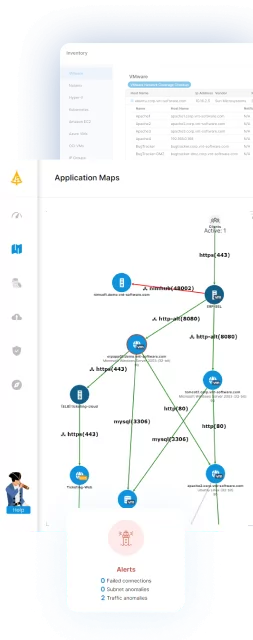What Is Cloud Workload Security?
Cloud workload security, also known as cloud workload protection (CWP), refers to the measures and technologies used to protect applications, data, and infrastructure within cloud environments. It ensures the confidentiality, integrity, and availability of cloud-based resources as they move across different cloud environments.
This protection is crucial because cloud workloads, which include applications, data, and their supporting infrastructure, can be vulnerable to various cyber threats.
Workloads in the cloud are dynamic, often spun up and down on demand, which introduces unique risks compared to traditional on-premises environments. Threat vectors multiply due to the distributed nature of cloud infrastructure, multi-tenant hosting, and a shared security responsibility model between cloud service providers and customers.
This is part of a series of articles about cloud security.
Table of Contents
Toggle- What Is Cloud Workload Security?
- Key Threats Facing Cloud Workloads
- Core Components of Cloud Workload Security
- Tips from the Expert
- Benefits of Cloud Workload Security
- Challenges in Cloud Workload Security
- Tools and Technologies for Cloud Workload Security
- Best Practices for Secure Cloud Workloads
- Supporting Cloud Workload Security with Faddom Dependency Mapping
Key Threats Facing Cloud Workloads
Cloud workloads are exposed to a range of security threats.
Unauthorized Access
Unauthorized access remains one of the leading threats to cloud workloads. Attackers look for misconfigured access controls, weak authentication, and vulnerabilities in identity and access management (IAM) systems to gain entry into cloud environments.
Once inside, bad actors may move laterally, escalating privileges or exfiltrating sensitive data, potentially impacting multiple systems quickly due to the interconnected nature of cloud workloads. These unauthorized activities often stem from simple missteps such as poor password hygiene, misconfigured IAM roles, or a lack of multi-factor authentication.
Data Breaches
Data breaches in the cloud can result in loss of intellectual property, disclosure of customer information, and regulatory penalties. Attackers often exploit weak encryption, poorly protected storage, or unpatched vulnerabilities in workloads to access and leak sensitive data. The ease with which cloud workloads can communicate with each other, or with external networks, amplifies the risk of data exposure.
Cloud environments also pose unique risks due to the rapid proliferation of workloads and containers, each of which can store or process confidential information. Misconfigured storage buckets, neglected API endpoints, and unsecured backups are frequent sources of breaches.
Malware and Ransomware
Cloud workloads are vulnerable to traditional and new forms of malware, including ransomware targeting cloud-hosted data and infrastructure. Compromised workloads can be used to spread malware laterally, steal credentials, or encrypt valuable resources, disrupting business operations and incurring significant remediation costs. Malware often enters cloud environments through compromised images, vulnerable third-party libraries, or malicious scripts.
Ransomware attacks in the cloud can be particularly damaging because infected workloads may affect both production and backup systems, complicating recovery efforts. Automated workload provisioning and software updates can unintentionally propagate malicious code rapidly across environments.
Distributed Denial-of-Service (DDoS) Attacks
DDoS attacks in cloud environments bombard workloads with large volumes of traffic to degrade performance, cause outages, or extort organizations with service disruptions. These attacks may target publicly exposed APIs, web applications, or critical microservices. Because cloud workloads scale dynamically, attackers may attempt to exhaust cloud resources, drive up costs, or force applications offline.
While some cloud providers offer built-in DDoS protection, not all workloads may benefit equally due to architectural complexity or custom exposure points. Attackers constantly evolve their techniques to bypass defenses by leveraging multi-vector approaches, such as blending volumetric with application-layer attacks.
Insider Threats
Insider threats involve employees, contractors, or business partners abusing legitimate access to cloud workloads for malicious or negligent purposes. Such threats are difficult to detect because insiders often have authorized access to sensitive workloads and data. Insider actions can include data theft, sabotage of cloud resources, or unauthorized changes that increase exposure to external threats.
The complexity and scale of cloud environments often make it challenging to track or audit every action by insiders, especially when multiple access points and federated identities are involved. Organizations must establish detailed monitoring, enable anomaly detection, and enforce segregation of duties to reduce avenues for abuse.
Core Components of Cloud Workload Security
Visibility and Discovery
Visibility and discovery are foundational to securing cloud workloads. Organizations need clear, real-time insights into all workloads, assets, and data flows to manage risk effectively. This includes automatic identification of new or modified workloads, mapping network dependencies, and understanding interconnections between resources.
Without strong visibility, security teams may miss unauthorized deployments or shadow IT activities that increase attack surfaces. Achieving visibility requires integration with cloud provider APIs, deployment of security agents, and utilization of centralized dashboards.
Vulnerability and Risk Management
Vulnerability and risk management involve identifying, prioritizing, and addressing exploitable weaknesses in cloud workloads. This includes assessing software configurations, patching systems, and tracking known vulnerabilities in operating systems, containers, and application dependencies.
Effective management requires automating vulnerability scans and correlating findings with real-time risk context, such as exploit availability or workload criticality. Prioritization is essential as cloud environments may contain thousands of assets, each with a unique risk profile. Security teams must triage issues to address the most critical threats first.
Access Control and Identity Management
Access control and identity management protect cloud workloads by verifying user and service identities and enforcing least-privilege principles. User provisioning, authentication, and authorization processes ensure that only approved individuals or systems can interact with workloads, reducing the risk of lateral movement or unauthorized access.
Multi-factor authentication, role-based access controls, and just-in-time permissions are best practices in this domain. Managing identities in cloud environments requires centralized IAM solutions that support automation, auditing, and integration with directory services. Cloud-native identity solutions often provide conditional access and adaptive risk-based authentication.
Runtime Protection
Runtime protection involves continuously monitoring workloads for threats and anomalous behavior while they are active. Techniques include behavioral analytics, intrusion detection, whitelisting allowed processes, and isolating suspicious activities in real time. Unlike static vulnerability assessments, runtime protection addresses attacks that occur during workload execution—such as privilege escalation, process injection, or lateral movement.
Effective runtime protection also requires real-time log analysis and integration with response mechanisms that can automatically quarantine compromised workloads. Cloud-native tools leverage telemetry data to detect and stop attacks as they happen, providing crucial alerts or triggering automated mitigation.
Compliance and Policy Enforcement
Compliance and policy enforcement ensure that cloud workloads adhere to regulatory requirements and internal security standards. This component relies on implementing controls that continuously check configurations, access, and data usage against defined policies, such as PCI DSS, HIPAA, or GDPR. Automated compliance checks detect misconfigurations or policy violations, enabling rapid remediation and maintaining audit readiness.
Policy enforcement is not only about regulatory compliance but also about aligning with organizational security frameworks. This may include enforcing encryption, logging requirements, or network segmentation policies.

Lanir specializes in founding new tech companies for Enterprise Software: Assemble and nurture a great team, Early stage funding to growth late stage, One design partner to hundreds of enterprise customers, MVP to Enterprise grade product, Low level kernel engineering to AI/ML and BigData, One advisory board to a long list of shareholders and board members of the worlds largest VCs
Tips from the Expert
In my experience, here are tips that can help you better secure and manage cloud workloads:
- Harden golden images before workload deployment: Build and validate hardened base images for VMs, containers, and serverless functions with preconfigured security controls. Enforce their use in CI/CD pipelines to prevent security drift during rapid workload provisioning.
- Scan infrastructure as code (IaC) for misconfigurations: Analyze Terraform, CloudFormation, and Kubernetes manifests for security issues before deployment. This preemptively closes gaps like open ports, weak IAM roles, and insecure storage settings.
- Establish identity-to-workload binding: Use workload identity federation (e.g., AWS IAM Roles for Service Accounts or Azure Managed Identities) to avoid embedding API keys and secrets into workloads. This reduces secret sprawl and risk of compromise.
- Use ephemeral workloads to limit attacker dwell time: Design workloads to be immutable and short-lived. Frequently redeploy containers or VMs from trusted images so attackers cannot persist even if they compromise a workload.
- Isolate management planes and data planes: Create separate cloud accounts, subscriptions, or projects for workload management versus data processing. This minimizes the blast radius if a management plane credential is compromised.
Benefits of Cloud Workload Security
Cloud workload security provides numerous benefits, improving both the security posture and operational efficiency of organizations. By effectively securing workloads in the cloud, organizations can ensure smooth operations, protect sensitive data, and reduce the risk of costly incidents. Key benefits include:
- Improved data protection: Cloud workload security helps prevent unauthorized access, data breaches, and data exfiltration, ensuring that sensitive information is securely stored and transmitted.
- Enhanced threat detection and response: By monitoring workloads in real-time, organizations can identify and mitigate threats quickly, reducing the time between detection and response to potential incidents.
- Reduced risk of compliance violations: With automated compliance checks and policy enforcement, organizations can more easily maintain compliance with industry regulations, avoiding fines and reputational damage.
- Minimized attack surface: Effective security measures reduce vulnerabilities in workloads, limiting opportunities for attackers to exploit weaknesses and reducing overall attack surfaces.
- Operational continuity: By securing cloud workloads against threats such as ransomware or DDoS attacks, organizations can maintain operational uptime and ensure business continuity.
- Cost efficiency: By preventing costly breaches and minimizing the impact of security incidents, cloud workload security reduces the potential financial loss due to downtime, regulatory fines, and recovery efforts.
- Scalability and flexibility: Cloud workload security frameworks scale with dynamic workloads, ensuring consistent security despite rapid changes in the cloud environment.
Challenges in Cloud Workload Security
Here are some of the main factors that make it more complicated to secure cloud workloads.
Dynamic and Elastic Nature of Cloud Environments
Cloud environments are inherently dynamic, with workloads spinning up and down on demand. This elasticity makes it hard for traditional security tools to keep pace with the constant change in asset inventory, configurations, and network topologies.
Security teams must adapt to momentum and continuous deployment, ensuring that new workloads are discovered and protected immediately as they appear. This dynamic nature also means threats can propagate quickly. Misconfigurations or vulnerabilities in newly deployed workloads might be exploited before they are even detected.
Complexity of Multi-Cloud and Hybrid Architectures
Organizations often adopt a mix of public clouds, private data centers, and edge deployments, creating a complex web of interconnected resources. Securing workloads in multi-cloud and hybrid architectures introduces challenges in maintaining visibility, consistent policy enforcement, and unified threat detection.
Each environment has its own APIs, security controls, and operational nuances, increasing management overhead. This complexity can lead to misconfigurations, redundant tooling, and gaps in coverage as security teams struggle to implement standardized controls across platforms. Migrating workloads between environments without disrupting protection levels further complicates matters.
Learn more in our detailed guide to cloud security architecture (coming soon)
Volume and Velocity of Security Alerts
The sheer volume and speed of security alerts generated by cloud workloads can overwhelm security operations. Automated monitoring, runtime protection, and multiple tool integrations generate vast amounts of data, much of it routine or low-priority.
Security teams may struggle to distinguish true threats from false positives, leading to alert fatigue and missed incidents. Addressing this challenge requires effective alert triage, correlation, and prioritization using automation and machine learning.
Tools and Technologies for Cloud Workload Security
There are several types of solutions that can help organizations improve their security posture in the cloud.
Cloud-Native Application Protection Platforms (CNAPPs)
CNAPPs combine multiple cloud security capabilities—such as workload protection, posture management, and entitlement management—into a unified platform. These platforms deliver end-to-end visibility and protection across cloud-native workloads, including containers, serverless functions, and VMs, throughout the application lifecycle.
CNAPPs continuously assess risks, detect configuration drifts, and enforce compliance across dynamic environments. By integrating capabilities such as vulnerability assessment, runtime protection, and cloud security posture management (CSPM), CNAPPs simplify security operations. They enable automation in policy application, anomaly detection, and remedial action while reducing tool sprawl and operational complexity.
Cloud Workload Protection Platforms (CWPPs)
CWPPs are specialized solutions designed to protect workloads running across public, private, and hybrid clouds. They focus on visibility, vulnerability management, application control, and runtime defense for VMs, containers, and serverless workloads. CWPPs deliver security controls directly to the workload, regardless of the underlying cloud infrastructure, enabling consistent protection and policy enforcement.
These platforms often include features like host-based intrusion detection, security monitoring, micro-segmentation, and behavioral anomaly detection. CWPPs work alongside existing cloud services to address threats unique to distributed cloud workloads, ensuring that security travels with the workload across all locations.
Cloud Access Security Brokers (CASBs)
CASBs serve as intermediary security layers between users and cloud service providers, enforcing enterprise security policies for data access, sharing, and collaboration. They provide detailed visibility into user activity, enable data loss prevention (DLP), and detect risky behavior in sanctioned and unsanctioned cloud apps.
CASBs help ensure that only authorized users have access to sensitive workloads and that sensitive data remains protected. They offer granular policy controls, encryption management, and threat protection features tailored for SaaS, IaaS, and PaaS environments. By integrating with IAM and endpoint security solutions, they deliver context-aware access policies and automate compliance reporting.
Security Information and Event Management (SIEM)
SIEM solutions ingest, correlate, and analyze security event data from cloud workloads and infrastructure components. By centralizing logs and alerts, SIEM systems provide real-time visibility, advanced threat detection, and incident response orchestration. They aid in identifying suspicious patterns, aggregating telemetry from disparate tools, and supporting compliance requirements through centralized reporting.
Modern SIEMs leverage artificial intelligence and machine learning to automate detection of complex threats and minimize response times. They integrate with playbook-driven orchestration tools (SOAR) to automate routine actions and enable coordinated incident handling. In cloud workloads, SIEM platforms are essential for correlating signals.
Best Practices for Secure Cloud Workloads
Organizations can further improve the security of their cloud workloads by following these best practices.
1. Adopt a Zero Trust Policy
A zero trust security model is crucial in protecting cloud workloads. The zero trust approach assumes no entity, whether inside or outside the network, can be trusted by default. Every access request is verified before being granted, regardless of the source. In cloud environments, this involves continuously verifying the identity and security posture of users, devices, and workloads before allowing access to resources.
To implement zero trust for cloud workloads, organizations should use strong identity and access management (IAM) systems, enforce multi-factor authentication (MFA), and apply the principle of least privilege for every workload and user.
Every request, even within the same network, must be authenticated and authorized, ensuring no unchecked trust is given to users or devices. This minimizes lateral movement within the network and reduces the risk of insider threats or compromised accounts.
2. Integrate Security into DevOps (DevSecOps)
DevSecOps integrates security directly into the DevOps lifecycle, ensuring that security is embedded into every phase of development and deployment. In the context of cloud workloads, this approach ensures that security practices are automated, tested, and enforced as part of the continuous integration and continuous delivery (CI/CD) pipelines.
By incorporating security into the development process, vulnerabilities can be identified and mitigated earlier, before they make it into production environments. This includes implementing automated code scanning, configuration checks, vulnerability assessments, and real-time threat detection within DevOps workflows.
DevSecOps helps organizations maintain speed without sacrificing security, ensuring secure cloud workloads are deployed at scale without introducing vulnerabilities or compliance risks.
3. Use Threat Detection and Response Tools
To protect cloud workloads effectively, organizations must implement threat detection and response tools that continuously monitor for suspicious activities and respond to potential security incidents in real-time. These tools use machine learning, behavioral analytics, and threat intelligence to identify anomalies that could signal a security breach or attack.
Cloud-native threat detection solutions, such as security information and event management (SIEM) systems, are essential for aggregating logs and alerts across cloud environments. These tools provide visibility into network traffic, user activities, and system behaviors, making it easier to detect abnormal patterns that may indicate malicious activity.
Coupled with automated response capabilities, such as isolating compromised resources or blocking unauthorized access attempts, these tools allow organizations to quickly mitigate threats before they escalate.
4. Implement Micro-Segmentation
Micro-segmentation involves dividing the cloud environment into smaller, isolated segments to limit the spread of attacks and reduce the attack surface. By segmenting workloads based on their functions, criticality, or sensitivity, organizations can enforce granular security policies for each segment.
This means that even if an attacker gains access to one segment, they are unable to easily move laterally across the cloud infrastructure. Micro-segmentation controls traffic flows between workloads, ensuring that only authorized communications occur.
By using virtual firewalls, access control lists (ACLs), and other segmentation techniques, organizations can implement this security model to improve their protection against both external and internal threats.
5. Educate Your Teams and Collaborate Cross-Functionally
A strong security culture is built through education and collaboration between teams. Securing cloud workloads requires the participation of developers, security experts, IT operations, and business leaders. Each team must understand their role in maintaining cloud workload security and work together to align their practices with organizational goals.
Regular training on security best practices, incident response protocols, and threat awareness ensures that teams are well-equipped to handle security challenges. Cross-functional collaboration also promotes the sharing of insights and the implementation of cohesive security strategies, ensuring all departments are aligned with the same security objectives.
Supporting Cloud Workload Security with Faddom Dependency Mapping
Faddom is an agentless application dependency mapping platform designed to enhance cloud workload security. It provides real-time visibility into how workloads, business applications, and infrastructure interact across cloud, on-premises, and hybrid environments. This visibility enables security teams to identify misconfigurations, shadow IT, and unexpected east-west traffic that could put workloads at risk.
By continuously mapping dependencies and data flows, Faddom supports segmentation strategies, detects lateral movement paths, and ensures that newly deployed workloads are tracked from the moment they go live. Its dynamic mapping capabilities also facilitate alignment with zero trust principles, runtime protection, and compliance policies by clearly showing what is connected and how.
To discover how Faddom can help secure your cloud workloads with complete dependency visibility, book a demo by filling out the form on the right!




